Today The Hidden Treasure selects Miss Nepal 2018 at Hotel De Annapurna!
Last Spring, some time before the Miss Nepal 2017 beauty pageant, doing some research, I hit on the list of winners. I noticed that most of them came from three ethnic groups: Bahun, Chhettri and Newar (BCN). I had a question about that fact, which I tweeted.
Most (18/22) Miss Nepal=BCN (Bahun Chettri Newar). Deliberate, coincidence or reality (ie they R d most beautiful)? https://t.co/bTEkFRJerS
— Dorje Gurung (@Dorje_sDooing) March 30, 2017
Of course, I should add that I am totally aware the crown of Miss Nepal does not go to the physically most beautiful contestant (however you may want to define physical beauty).
Reproduced below is the information about the ethnicity of the contestants as well as the winners, including data from last year’s pageant. Notice how they contrast with the composition of the population.
(Incidentally, Chhetri, Chhettri, Chetri and Chettri refer to the same ethnic group.)
To reiterate, what are the reasons behind a disproportionate percentage of contestants (78%), runners-up (72%), and winners (79% ) being BCN (34% of population) and almost half (46%) of all winners being Newar (5% of the population)?
The proportionally much lower representation (of less than 30%) of the “Others,” a demographic representing the majority (66%) of the population, cannot be explained statistically! The explanation must lie elsewhere.
The Contestants
Let me start with a discussion of the disproportionate representation in the contestants pool. The following tables show the breakdown by year.
What is the reason for the incredibly disproportionate representation of BCN women?
Does the explanation lie in where the three ethnic groups stand relative to the rest of the population when it comes to privilege? I think so.
What I am going to do is to connect the level of privilege the three groups enjoy to a number of the “prerequisite” for participation in the event.
The Khas-Aryas, the Bahuns and Chhettris, are the most structurally privileged groups in the country and therefore disproportionately represented in the power structures. From when the first Shah king ruled the country, they have enjoyed benefits that few or no other ethnic groups have, making them politically very powerful and very wealthy. Newars are also pretty highly privileged for other reasons.
While there is no direct quantitative measure of privilege, Human Development Index (HDI) is an indicator of inequality in a country and therefore an indirect measure of relative privileges enjoyed by different groups.
Historically, the BCNs, on average, have enjoyed the highest literacy and income rates, as the table below of literacy rate and per capita income for 1996 show.
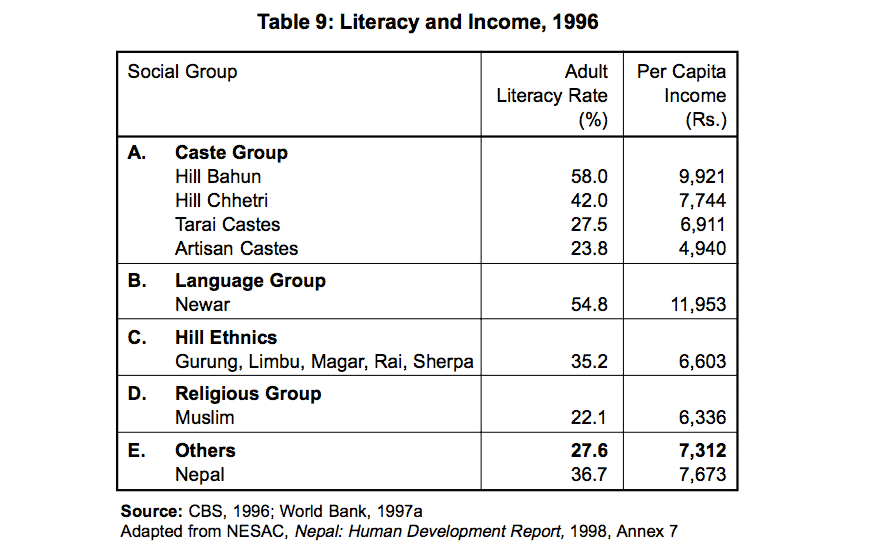
Per Capita income: Newar (1st): 11,953; (Hill) Bahun (2nd): 9,921; (Hill) Chhetri (3rd): 7,744
Source: Trident and Thunderbolt: Cultural Dynamics in Nepalese Politics, by Dr. Harka Bahadur Gurung.
A look at the HDI table for 2011 shows the same three groups among the top four!
Madhesi #Dalits lowest #HDI, then Muslims, then Hill Dalits. Source: #Nepal HDI Report 2014. https://t.co/UtzK00WEHM pic.twitter.com/mhHycgL1IB
— Dorje Gurung (@Dorje_sDooing) June 11, 2016
Newars have the highest HDI value (at 0.565) followed by Hill Brahman (Bahun, at 0.557), then by Madhesi Brahman/Chettri (at 0.536), and rounded off by (Hill) Chhetri (at 0.507).
Found on the application form, here are the “prerequites” aspiring contestants have to fulfill to begin with, followed by a discussion of each one of them and HDI.
Aspiring #MissNepal contestants submit d following info & documents. Little is requested, but invitation to participate based on them! pic.twitter.com/iAbcKpE1y4
— Dorje Gurung (@Dorje_sDooing) April 1, 2017
(The application for 2018 is available in a PDF format as well.)
Here’s the first and the third prerequisites together:
The applicant should be single/never married/naturally born female Nepali citizen.
Age should be between 19-25 [sic] years.
Is it possible that BCNs, because of their better economic standing and higher level of education in the country on average than the rest, don’t have their daughters married off before twenty and therefore a higher percentage of them in their population fulfill this prerequisite?
(I’ll return to why the Madhesis Brahman/Chettri might not have anywhere near as high a representation later.)
There are those in Nepal who marry their daughters off before twenty for financial and/or other reasons. Those with low level of education, follow traditional practices which generally also means marrying off their daughters at a young age, even as young as when they are below 14. According to the 2011 census report, of the 69% of women who were married (off), 74% (3 out of 4) had done so before they turned 20! I am willing to bet that the proportion of BCN in that group is significantly smaller than the “Others.”
The second prerequisite says:
Never given birth.
Is it possible that, again because of their better economic status and higher level of education, BCN females, on average, are able not only to stave off marriage proposals for themselves and/or to convince their parents to NOT have them married off before twenty, but also do not engage in risky sexual activities when single thus avoiding unwanted pregnancies and therefore qualify for the event?
Studies elsewhere, notably the USA, have shown a significantly higher incidence of teen pregnancies in poorer and less educated groups. (A study of the incidence of unwanted pregnancies out of wedlock in young females of different ethnicity in Nepal could produce some interesting results because of differing views of and attitudes towards sexual mores.)
The fourth one says:
Minimum academic qualification should be 10+2 or equivalent. [10+2 is equivalent to the last two years of high school in the US and sixth-form in the UK.]
According to the 2011 census report, the percentage of females in the country above 5 years of age with that qualification or above is less than 4%. But, given the BCN’s high HDI values, is it that their average number of years in school is considerably higher than the national average leading to a significantly higher percentage of them than others fulfilling this prerequisite? Studies have shown again and again that children of educated parents, on average, stay in school longer. BCNs, on average, are the most educated in the country.
Plus, in 2001 BCNs had the highest number of representation (box 2 on page 25) in the highly educated category. Could that also mean that they grow up in a social milieu that nurtures and encourages their personal growth, their goals, and their dreams considerably more and thus could grow up being considerably more confidant and ambitious on average than others? Could it?
The fifth one is about minimum height.
“The minimum height should be 5 ft 4 inches (164.6 cms [sic]).”
The average height of a Nepali woman aged between 25 and 49, based on data collected between 1994 and 2008, is 150.8 cm (4 ft 11 1/2 in). That’s almost 5 inches shorter than the minimum height required! Of course, the average height is for a different age group from aspiring pageant contestants. Regardless, does the minimum height requirement selectively disqualify women?
Height is both genetic and environmental. One might be genetically predisposed for tallness but if one suffers from undernourishment, one might not grow up to be as tall as genetically predisposed.
When it comes to the height of Nepali women (and men), I am pretty certain that there’s at least slight variation in the average height of different ethnic groups.
I don’t know who among different Nepalis are predisposed for tallness but, I suspect, based just on personal observations, BCN more than others, with the exception of the Madhesis, the indigenous population of the southern plains.
Additionally, being wealthier, also on average, they are able to provide adequate and healthier food to their children. Studies have indeed discovered socio-economic standing does affect height.
I suspect, therefore, that on average BCN (and Madhesi Brahman/Chhetri) women are taller than others in the country. (A comparative study of the average height of people from different ethnic groups could be interesting, if that has not already been done.)
Does that then lead to a significantly higher percentage of BCN females in the age group fulfilling the prerequisite than others? Is that partly why they are so disproportionately represented?
And finally, the sixth and seventh prerequisites:
Applicant should be attractive, possess sound health and have a good moral character.
No tattoo on the body.
As in many other countries, the models of beauty in Nepal are the celebrities, specifically actresses and models.
If a Nepali woman believed herself to be “attractive,” the reason is most likely to be that she believes she looks like, or meets the criteria of, “a beautiful woman” from the world of celebrities. I am willing to wager that a vast majority of Nepali actresses, models and other female celebrities (VJ’s, TV anchors, for example) also belong to the BCN trio of ethnicities.
Nepali culture associates paleness with beauty, health, wealth as well as with hill so-called high castes (Bahuns and Chhettris) and so high social status.
Low castes, especially the Dalits, have darker or dark complexion.
That, however, is NOT to say that there are no hill so-called high castes with dark complexion and no non-high castes with fair skin. It is NOT true that every group of non-high caste Hindus have darker complexion than the hill so-called high castes. Within Newars too, there are both fair- as well as dark-skinned sub-groups.
That cultural practice of associating paleness with wealth was really hit home by the rent-seeking mentality developed over time when certain people were given huge land grants many lived off of. Those people were predominantly the Khas-Aryas, the Bahuns and Chhettris! The tradition of living off the income from ones properties was begun following that. Being pale, for example, signified — or was interpreted as, among other things — being privileged enough to be able to do that, and not have to go and labor outdoors in the sun, and get burnt brown.
As a matter of fact, when Nari, a weekly supplement of the Kantipur Publication, featured the winner of the 2017 pageant on their cover, they photo-shopped her photo to make her look considerably paler! @Chaukath pointed that out (in Nepali) in a Tweet, which I retweeted with the English translation.
“You can make Nikita Chandak even more white in this photo @kantipurdaily.”
(Fact: Editor of Nari (woman) is a MAN!) https://t.co/fWkJkoZI8u
— Dorje Gurung (@Dorje_sDooing) June 14, 2017
Here an image of @Chaukath’s tweet.
Wouldn’t that, in general, lead to a higher proportion of the BCNs women thinking, believing, and being told, that they are “beautiful” than women of other ethnicity, leading to a significantly more of them applying to compete in the event?
As for sound health, good moral character and tattoo on the body…what can one say about them!
On a side note, of course, it’s entirely possible that these are the criteria set down by the international pageant organizers!
Continuing on with the discussion on why such a disproportionately high percentage of contestants are BCNs….
Could another reason be their attitude towards such events?
Is it possible that, again because of BCN’s higher level of education on average compared to other groups, BCN families are considerably more liberal (by Nepali society standards, of course) and more open to their daughters participating in such events?
Another issue is financial. The winner gets a mere Rs. 100,000 (approx. USD1000) prize money! Considering the time and money the contestants have to invest, that’s not really much! To say nothing of the other time commitments, they have to undergo a seven-week personal development training course for a fee, which the course application form does not reveal. (This colorful and big PDF document has those and other details about what went on in the 2017 pageant if you are interested.) As has already been pointed out BCN’s, on average, are wealthier than others.
And finally, could the unconscious bias of those selecting the contestants from the pool of applicants also play a role in who is selected?
Looking at the application form, you will have noticed that not much information is being asked of the applicant. I wonder if there’s more, like an interview because what the applicants provide is not much to go by, unless the decision is based mostly on the photograph! Or, unless they also go by what they can find in the public domain, like photos in publications, or music videos, especially if they happen to be a model, which quite a few of the contestants are. I wonder!
Returning to the Madhesi Brahman/Chhetri….If the reasons I have enumerated are indeed the reasons/explanations for disproportionate representation of BCN women, how come the Madhesis Brahman/Chhetri, scoring even higher than the (Hill) Chettri in the HDI, don’t have anywhere near as high a representation?
The reason may lie in the fact that Madhesis in general — IN GENERAL — are darker than BCN’s. Indigenous Southern women, who otherwise fulfill all the prerequisites, might be self-selecting themselves out of submitting the application knowing how their skin tone is viewed by Nepali culture, by Nepali society, i.e. by the Nepali people. Or, even if many of them do apply, those in the selection committee might not select them for precisely that reason. After all, Miss Nepal 2017 of Indian heritage, was photo-shopped to make her paler than she is!
The other reason may have to do with the way Nepalis in general view and treat our fellow citizens indigenous to the southern plains: they are discriminated a lot! That MAY play out in some way in this process and in the event. That MAY!
The Winners
What of the disproportionate representation of BCNs in the runners-up category and those winning the crown?
How does it look statistically?
Except for once (in 1996) when “Others” were the majority and three times (in 2005, 2009, 2011) when they tied with one of the three dominant groups, pretty much every single year, one of the three had the highest representation in the contestants pool.
Regardless, on average, every contestant from the “Other” group (representing 66% of the population), competed against three from BCN group (representing 34% of the population)! In other words, the odds of someone from the “Other” group winning is 1 in 4! Some years it’s worse. No wonder the ratio of Other winners: BCN winners is just 5:18 (approximately 1:4), which makes sense statistically!
What about the judges?
Here’s how their composition breaks down.
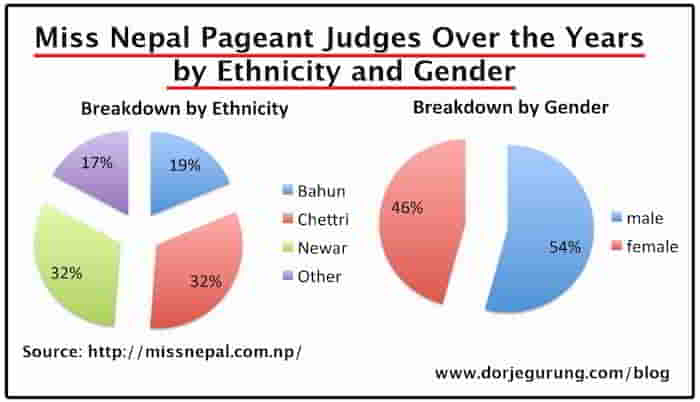
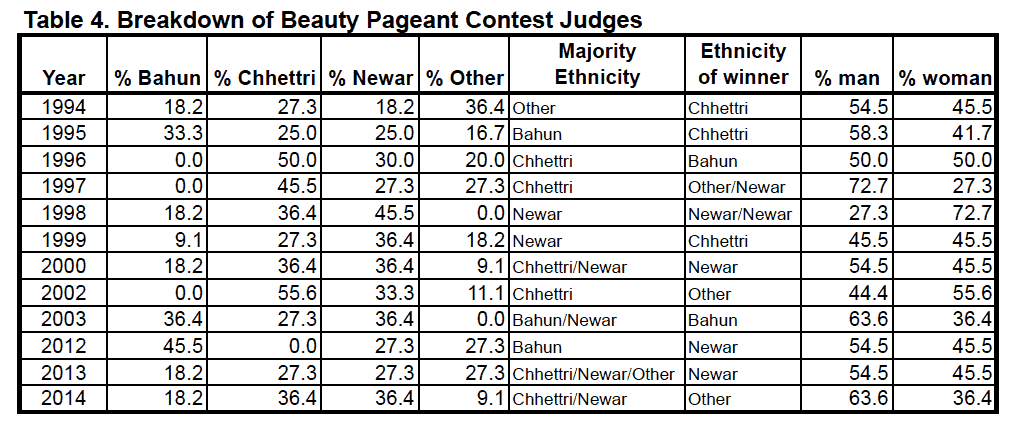
Of course, it is NOT a given that a BCN will select a BCN winner, and I am NOT suggesting that. I am sure they have some kind of criteria against which they are required to judge the contestants.
However, the Kathmandu elite are given to very condescending and patronizing attitudes towards the “Others.” In “The local people should improve the quality of their lives.” […] “But let them not wear ties” I detail an example of just such an attitude towards my people of Mustang district. In F*ck the Beach; Mount Everest!, I have written about the manner in which hill so-called high caste Hindu officials find fault with the character of the non-high caste population of Kathmandu in explaining the prevalence of a higher percentage of non-high caste Hindu street children compared to those of the hill so-called high castes.
Could some of the judges hold unconscious biases against the “Others” which cloud their judgement?
Returning to the judging criteria, I am sure they are not EXCLUSIVELY about facial appearance, body size/measurements and type etc., i.e. not entirely about the contestant’s physical attributes.
But still, how much does appearance play a role in a contestant coming out victorious? How much do the mostly BCN panel of judges share their ideas of “beauty” with the general population, whose idea, I would say, is reflected in, as well as based on, the appearances of actresses and models? To reiterate something I mentioned above, I wouldn’t be surprised if most Nepali actresses and models belong to the BCN trio of ethnicity. If the judges’ view of the “beautiful” is the same or similar to the general population, of course, it’s understandable that BCNs come out the winners most of the time.
Furthermore, given pretty much all the judges appear to also be products of Nepali culture and society, it’s not unreasonable to assume that they, especially the Bahuns and Chhettris, most likely subscribe to mainstream Hindu-based cultural beliefs and practices, and hold mainstream views (about talents, about opinions/viewpoints/ideas and about values etc.). The ability to speak three or four national languages, for instance, might not be viewed as a talent! In the case of Newars, they may be biased towards elements of the Newari sub-culture.
Could the organizers also be, in some way, responsible for the kind of representation we see in both the contestants and winners? The Board of Directors of The Hidden Treasure consists of nine Newars and one Chhettri (all of them men)! Could that be having a bearing on who wins?
Conclusion
Taking the results of the beauty pageants in Nepal of the last two decades at face value, one would conclude that BCNs indeed are the models of beauty in the country.
Except, of course, one does wonder if the views of the society about what “being beautiful” means, as well as who is/can be beautiful, have been shaped by the glamor industry as well as by these beauty pageants themselves. What I mean is, it’s possible that the society now generally accepts BCN women as the models of beauty in the country for no other reason than the fact that they have been recognized/accepted as such for a sufficiently long time.
Anyway, there you have it, my tentative explanations for why the event is characterized by participants and winners from the very privileged groups in the country. In other words, the beauty pageant is really of the BCN, by the BCN, for the BCN! 😀 😀
Oh, if you are wondering, I am NOT in any way insinuating or suggesting that the event should be considerably more inclusive!
Not at all. Why would I?! It would be quite stupid to insinuate or suggest or expect that! (I don’t even believe in beauty pageants, but that could be a whole different blog post altogether.) That however was precisely what someone accused me doing when I shared an earlier version of the charts on Twitter sometime last June!
And finally, coming back to today, at Hotel De Annapurna…. What are the chances of a contestant other than a BCN winning the pageant today? Not good at all! It’s 1 in 25!
But…go Sayara Lama! (She is the sole non-BCN contestant!) 😀 😀
What do you think?
April 12 Update
In spite of more than half of the contestants being Bahun, a Chhettri, Shrinkhala Khatiwada, won the crown (of Miss World Nepal 2018)!
April 17 Update
A Facebook friend alerted me to the fact that Nikita Chandak was asked a blatantly rude question after she was crowned Miss Nepal 2017 which revealed a few things about the interviewer.
It reaffirms my argument above about how the general idea of beauty is being fair-skinned!
Here’s the question (enclosed inside yellow circle below): “In spite of being black, you still became Miss Nepal?”
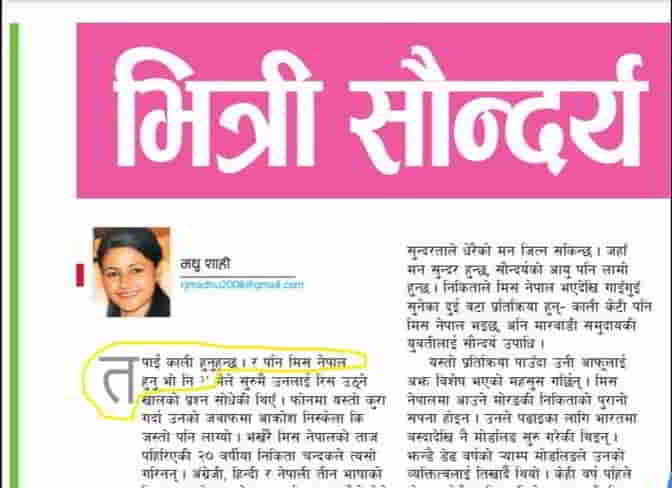
Crazily, the interviewer follows that question up with: “I had initiated the phone conversation with a question that could anger a person.” In the next sentence, she — yes, the interviewer is a SHE — concedes, “Asking such a question, I thought she might respond with anger.”
So, this woman journalist, firstly, revealed how narrow a view she had of beauty and who SHOULD become Miss Nepal. And, secondly, she was completely aware of what she was doing AND the kind of response she could have gotten from Chandak, and yet she went ahead with it!
Had Chandak reacted in the manner expected, I have no doubt that the interviewer would have used that against not only her, but also against her entire ethnicity! In Nepal, as in most other countries, anything anti-social a minority does or anything wrong they say, member(s) of the majority will paint it as a reflection of the character of the group as a whole AND slam the group! (When I was growing up, I had to make sure to NOT do anything which would elicit the reaction: “What can you expect from a Bhote?!”)
Chandak, however, did not stoop to her level and surprised her with a measured, thoughtful and a very apt response, which you can read in this online version of the article published by Kantipur. (If, for whatever reason, that article disappears, RangaPost has reproduced it here.)
May 4 Update
Came across the following article in The Nepali Times published on June 12, 2017. One of the things it noted is,
“the selection of Nikita Chandak as Miss Nepal last week was unexpected because of what many deemed to be her unconventional looks, the fact that she was not ‘fair’, and that this was the first time a person from the Marwari community and a Tarai resident was selected. The trolling on social networking sites proved that it is perhaps society’s notions about stereotyping and beauty that needed to change rather than beauty pageants themselves.”
* * * * * * * *
References
Added after the publication of the blog post for their relevance.
PahiloPost.com (Oct. 6, 2018). सुन्दरीको खेती : प्रतियोगीकै गोजीबाट आयोजकलाई आम्दानी! (Beauty Farming: Organizers Profit from Contestants). A scam pageant where the contestants, once lured into participating in the pageant ended up paying a little sum here and a little sum there for all the different activities and “training” they were required to participate in. They ended up not getting the “training” they were supposed to have, and the winning prize money, which was advertised as 25K, ended up being only 10K! [Added on Oct. 8, 2018.]
The Kathmandu Post (Sept. 12, 2018). Clamour for Glamor. Excellent piece describing some of the issues with beauty pageants in the country. [Added on Dec. 14, 2018.]
Annapurna Post (Sept. 18, 2021). कोही व्यवसायमा, कोही घरगृहस्थीमा त कोही विदेशतिर. An article about the whereabouts of 25 Miss Nepal. [Added on Sept. 18, 2021.]

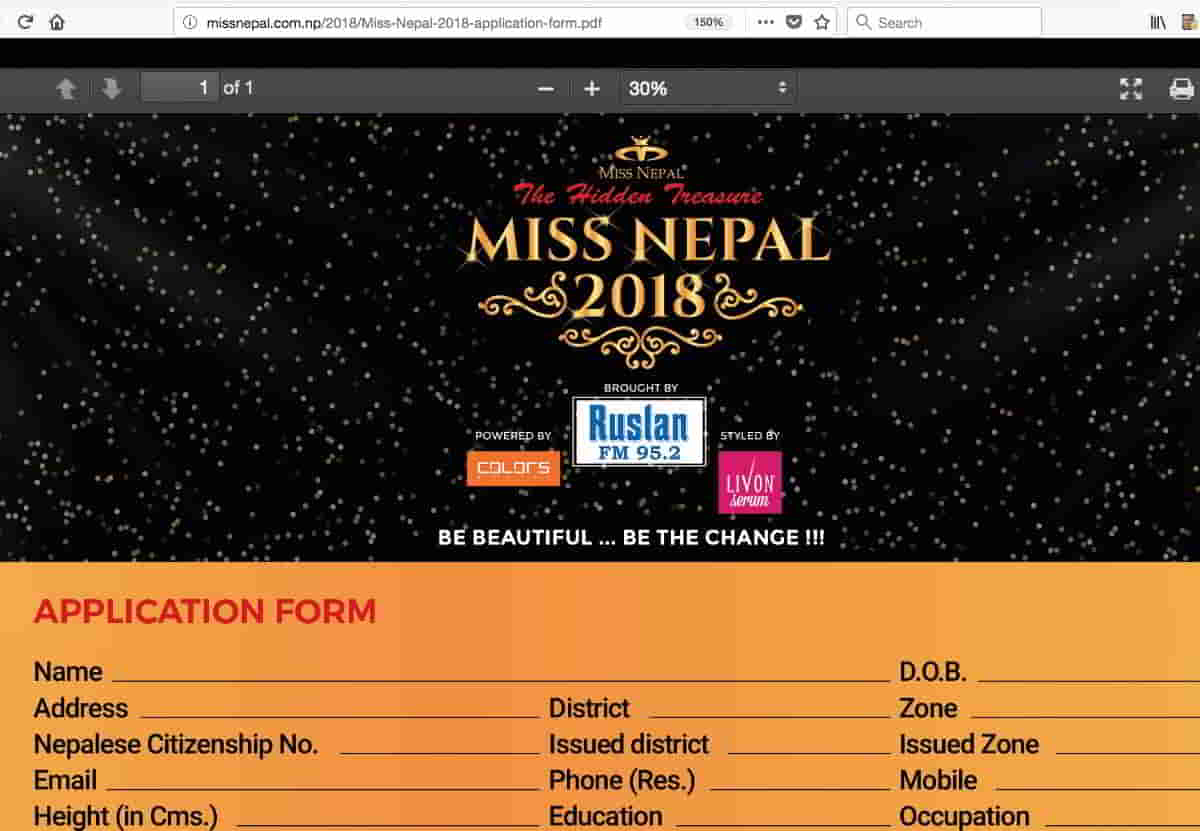
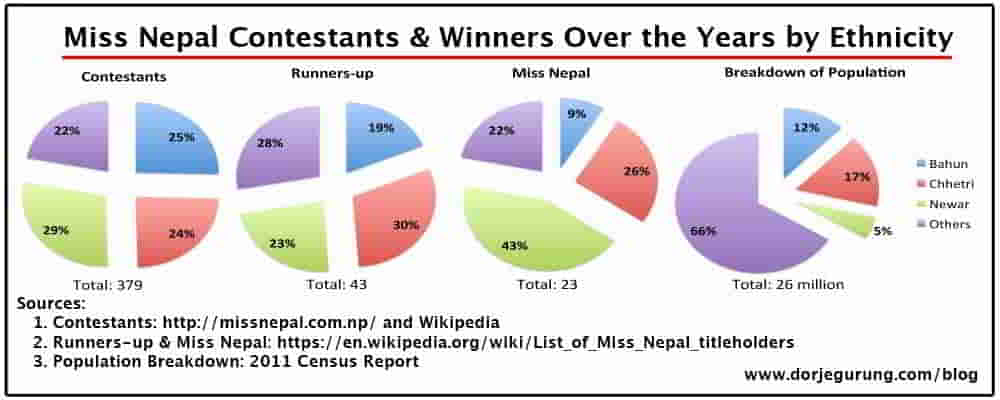
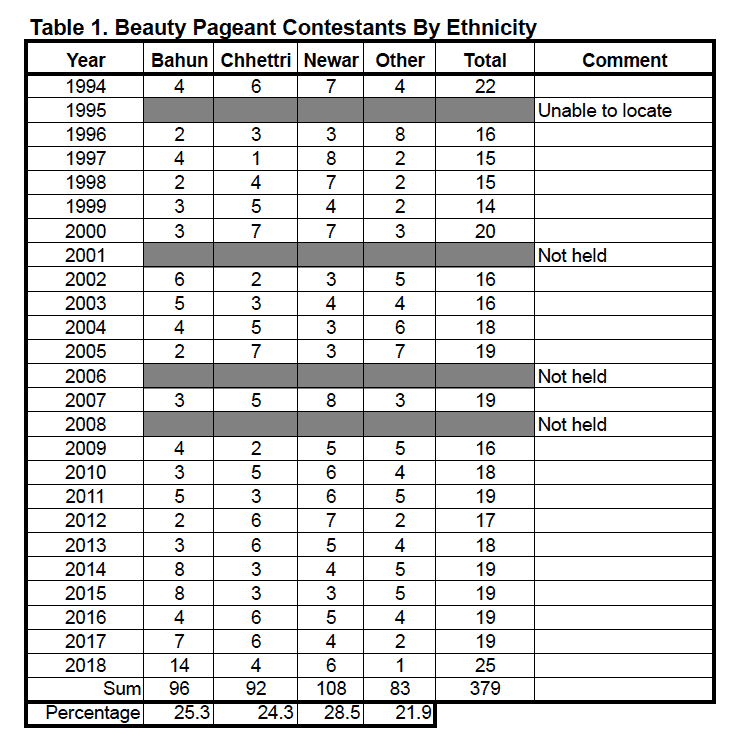
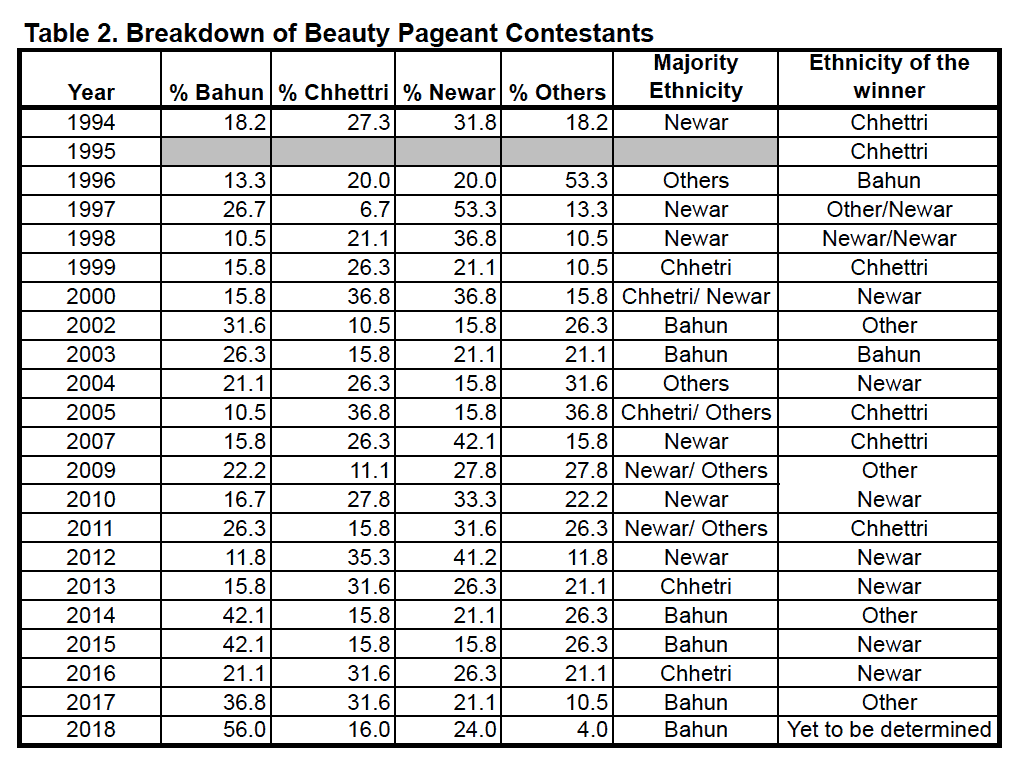
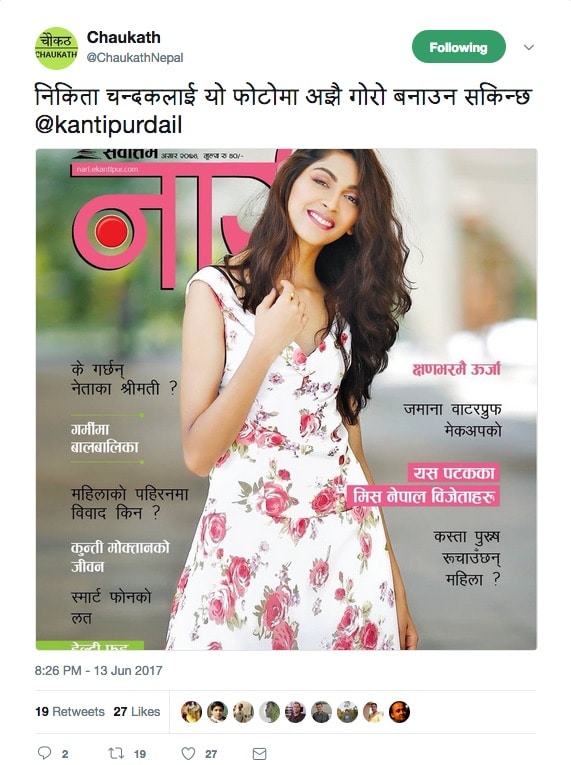
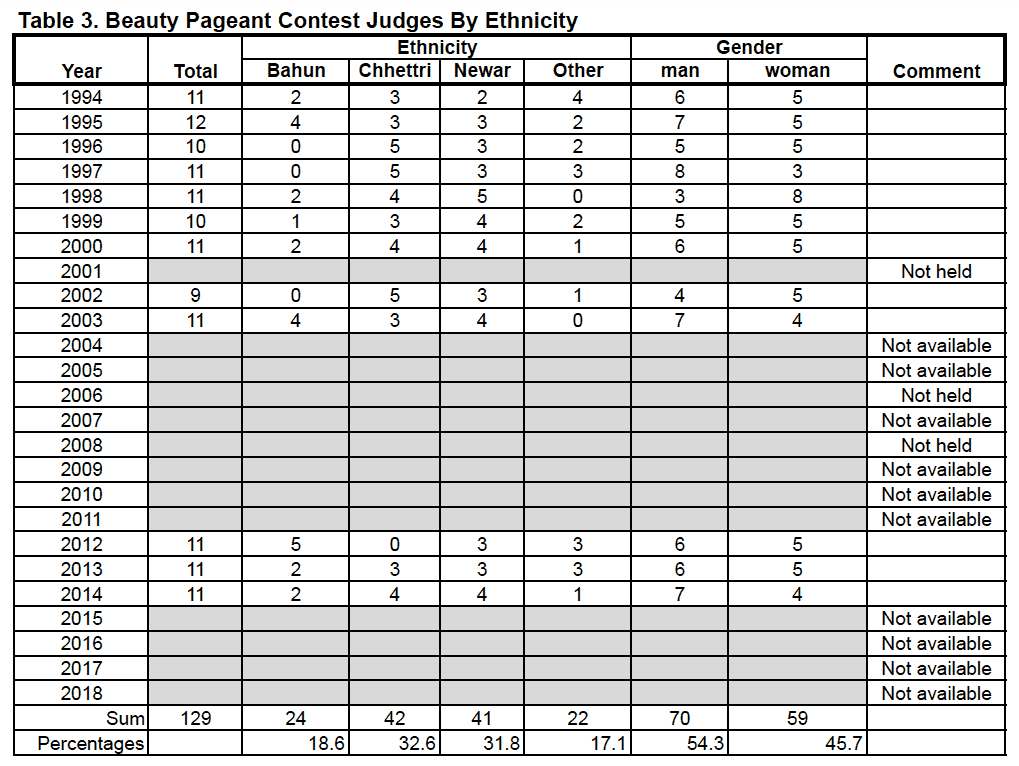
Also, 2011 Winner Malina Joshi is also a Newar Joshi from Dharan
Yes I theorize it does with that you have illustrated in your arguments.
First off, high-caste Newars (both Hindus and Buddhists) in general are more economically and socially advanced. Hence, they have had the social and economic capital, more exposure, more opportunities which has affected who they lead their lives, from food habits to social cricles. Secondly, high-caste Newars in general are more fairer than middle and lower caste Newars. this could be another important reason for them to be considered as more beautiful as per the traditional myopic definitions. Hindu Newars like the Chathariyas and Shresthas are also in addition to be traditionally believed as relatively recent migrants to Nepal Valley from India, and they often (again in general comparatively) also look more Aryan (Caucasoid) in their physical features than other middle or lower castes. They fit right into, as well as propagate, the dominant (upper-caste Hindu) definitions of who is beautiful in Nepal.
Domination of Shresthas and other upper-caste Newars is not limited to the field of pageantry and beauty contests. For example, the Chathariyas and Shresthas for example make up less than 25% of actual Newar population, or just above 1% of Nepal’s population, but if you actually calculate their share of power and influence in all social and economic fields of Nepal, they will without doubt, be the most over-represented caste group of Nepal. much above Bahuns even.
Most of the Newar women who have won also come from mostly the Hindu upper-caste divisions, specifically from the Shrestha caste (your Shrestha, Joshi, Rajbhandari, Vaidya, Pradhan), and also from Buddhist upper-castes (Vajracharya and Shakya). Only Manandhar and Khadgi could be called as non-dominant castes that have won, but even they are from urban educated backgrounds. My questions is where are the Maharjans, Tuladhars, Deulas, etc. who actually make the majority of the Newar population.
Dear Ajit,
Thanks for that! I went back and had a look and you are indeed right!! Once again, thank you for pointing that out.
And as you say, where are the others? Why are the other Newars NOT represented at all? Could the same arguments I have made above apply? What I mean is, are the differences between the upper-caste Newars and other Newars similar to the enumerated differences between BCN and other castes? That is indeed an interesting question.